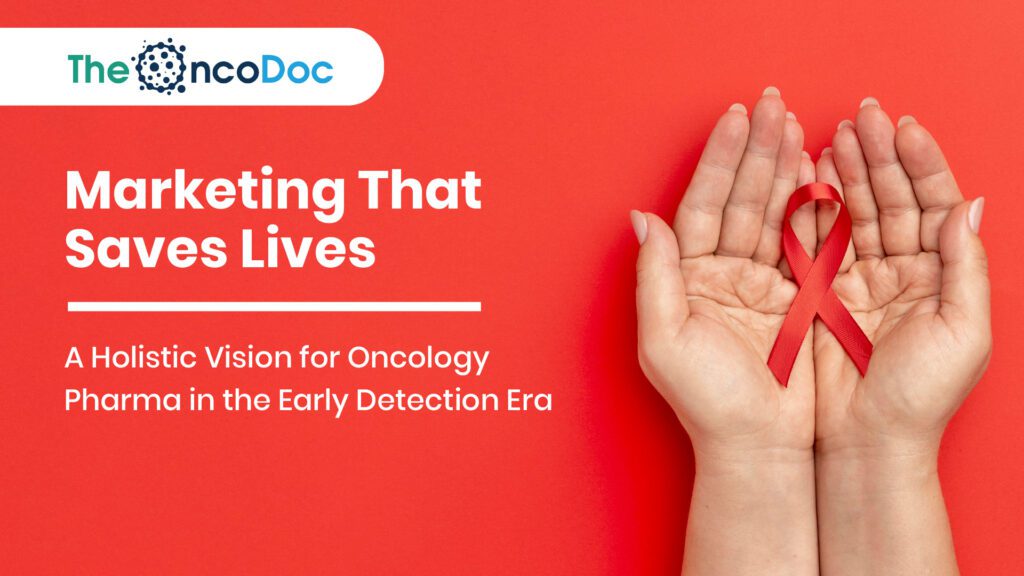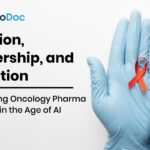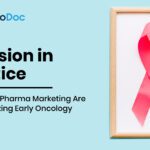Introduction: Beyond the Molecule; A New Role for Pharma in Oncology
Traditionally, pharmaceutical companies in oncology have focused on post-diagnosis strategies, medical detailing, treatment promotion, and physician engagement. But with over 68% of cancer cases in India diagnosed at an advanced stage, a paradigm shift is imperative. Today’s oncology pharma brand manager must think beyond the molecule and ask: How can we influence early detection, faster referrals, and holistic patient journeys?
Digital marketing is the lever. The rise of AI, hyper-local platforms, mobile-first behavior, and content personalization presents pharma with unprecedented power, not just to reach, but to reshape healthcare behaviors. By placing themselves at the intersection of awareness, access, and action, pharma brands can drive both impact and equity.
This article outlines how oncology pharma teams can use digital channels, data, partnerships, and narrative strategies to lead campaigns that save lives, before the prescription pad is even used.
Section 1: Why Oncology Pharma Must Move Upstream
Late Diagnosis: A Public Health Crisis
Cancer mortality in India is often the result of diagnosis delays, not just disease severity. As India’s annual cancer incidence is projected to exceed 1.62 million cases by 2026, it becomes increasingly critical to address the root causes behind late presentation. These delays are not purely clinical, they’re socio-behavioral, infrastructural, and informational.
Key Factors Contributing to Late Cancer Diagnosis in India (2024)
This data paints a clear picture, behavioral and systemic gaps are major contributors to diagnostic delays. For pharma companies in oncology, these aren’t just problems for the public sector to solve. They represent a strategic inflection point: pharma marketing can shift from pushing products to enabling solutions.
Digital outreach, GP sensitization, and patient-facing education tools can empower early action. In this new era, the real value lies in helping patients enter the system sooner, not just faster treatment once they do.
Section 2: The Digital Advantage in Driving Early Diagnosis
The conventional approach of deploying field reps to engage oncologists, while still valuable, is no longer enough in a landscape where speed, scale, and personalization define effectiveness. In the age of smartphones and digital ecosystems, pharma must evolve into a digitally agile health enabler.
Why Digital Wins in Oncology Outreach:
- Precision targeting based on specialty, pin code, language preference, and even risk prevalence
- Live campaign tracking, measuring HCP and patient interactions in real time, from video views to referral link clicks
- Intelligent engagement tools like symptom-checker bots, nudging GPs with timely updates, and regionalized content scheduling
Digital platforms empower pharma brands to deliver consistent, contextually relevant content, whether it’s pushing a cervical cancer screening message to a Bihar GP or a tobacco-cessation module to Northeast India.
Moreover, digital is democratizing influence. Through tools like WhatsApp, Telegram, and Hidoc Dr, pharma can reach Tier 2 and 3 markets where rep access is limited. The result? A high-impact, low-friction model of engagement that’s both cost-effective and outcome-oriented.
With the right strategy, pharma marketing doesn’t just scale faster, it thinks smarter, operating at the intersection of public health urgency and tech-driven precision.
Section 3: Engaging General Physicians as the First Line of Defense
Why GPs Matter More Than Ever
Over 60% of cancer cases begin with a visit to a general physician (GP), not an oncologist. Yet, few GPs are trained to suspect cancer early, especially in rural or peri-urban India.
Pharma companies can lead clinical capacity building via digital channels:
Campaign Ideas:
- WhatsApp micro-learning modules on red-flag symptoms (e.g., hoarseness >2 weeks, post-menopausal bleeding)
- Gamified quizzes with CME points and Amazon vouchers
- AI-powered referral calculators integrated with EMRs or Hidoc Dr-like apps
These tools should be multilingual, lightweight (2G friendly), and culturally contextual.
Preferred Learning Channels of Tier 2/3 GPs
Digital must become the default for medical knowledge dissemination.
Section 4: Humanizing Campaigns Through Survivor Voices
Marketing in oncology must go beyond clinical information. It needs emotion, the lived stories of those who fought and won.
Pharma + Patient Voices = Credibility + Empathy
Strategies:
- Survivor-led Instagram Reels on early warning signs
- YouTube “Day in the Life” interviews with rural survivors
- Co-branded webinars: oncologist + survivor + GP + NGO
Stories convert fear into action. Campaigns with real faces outperform generic messaging.
Section 5: Leveraging AI for Hyper-Personalized Outreach
Artificial Intelligence is reshaping pharma marketing from broad messaging to intelligent, hyper-targeted interventions, especially in oncology, where timing and personalization can directly impact lives. AI enables pharma to move beyond static campaigns to dynamic, behavior-led engagement tailored to users’ needs and contexts.
Key Applications:
- Multilingual AI chatbots that engage patients in regional languages, helping them assess symptoms and locate nearby diagnostic centers
- Geo-analytics and referral prediction models that flag districts with low early-detection rates and prompt targeted interventions
- HCP-specific micro-content delivery, like nudging a general physician: “2 of your recent patients fit early colorectal cancer risk profiles, consider screening?”
By harnessing AI, pharma can proactively identify gaps in awareness, access, and action, and deploy the right content to the right audience at the right time.
What makes AI transformative isn’t just automation, it’s relevance at scale. Whether it’s prompting a hesitant patient in Jharkhand or nudging a GP in Rajasthan, AI ensures no opportunity for early detection is missed. In the evolving oncology landscape, AI-powered outreach doesn’t just increase reach, it deepens impact, helping pharma create smarter, more empathetic, and outcome-driven campaigns.
Section 6: Geo-Targeted Digital Campaigns for High-Burden Zones
ICMR data shows clear patterns of regional cancer prevalence.
- Cervical cancer is more common in Uttar Pradesh and Bihar
- Lung cancer dominates urban Maharashtra and Delhi
- Head & neck cancers are prevalent in Northeast India
Digital allows pharma to design district-specific messaging.
Example Tactics:
- Google Ads for “mouth ulcer >2 weeks” in Manipur
- Facebook polls on tobacco use in Maharashtra
- Vernacular YouTube bumpers during IPL streaming in Bihar
Smart segmentation improves both ROI and public health outcomes.
Section 7: Empowering Oncologists as Educators
Oncologists trust pharma for scientific accuracy. Pharma can empower them to also become public educators.
Digital Assets to Provide:
- QR code posters for waiting rooms (linking to early detection videos)
- Instagram carousel slides: “5 warning signs to never ignore”
- Printable symptom cards in regional languages
- Toolkits for World Cancer Day with branding + statistics
Enable every oncologist to influence 50 more people outside the clinic.
Section 8: Data-Driven Optimization of Campaigns
Every digital asset must be measured and iterated.
Key Metrics to Monitor:
- Heatmaps of high-conversion zones
- Click-through rate on symptom ads
- Revisit frequency on resource microsites
- Referral form downloads over time
- Language preference trends
Pharma must treat marketing like product design, with continuous improvement loops, user testing, and segmentation.
Section 9: Multi-Stakeholder Collaboration is Key
Pharma must move from campaign owner to ecosystem enabler.
Ideal Collaborators:
- District cancer officers (data access + credibility)
- NGOs (trust + grassroots connections)
- Survivors (authenticity)
- Digital health platforms (scale)
Mini Case Study: Cervical Cancer Early Detection – Tamil Nadu
- Partnered with local gynecologists and self-help groups
- WhatsApp bot sent automated reminders for HPV self-test kits
- Radio + YouTube + WhatsApp used as multichannel approach
Results:
- 1.7 lakh interactions in 4 weeks
- 12,400 self-tests ordered
- 49% increase in screening compared to previous month
The future is not siloed. It is shared success.
Section 10: Aligning with Government Schemes and Policy
In today’s evolving healthcare landscape, oncology pharma marketing must move in sync with national health priorities. Collaborating with initiatives like Ayushman Bharat, state-level cancer control programs, and India’s digital health mission not only amplifies reach but strengthens credibility and impact.
Strategic Integration Opportunities:
- Co-create digital screening tools with the National Health Authority or state health departments to improve early detection outreach
- Leverage UHI-compatible APIs to embed pharma-supported tools into existing government diagnostic platforms
- Deploy patient triage dashboards that can serve both public health officers and community clinics for faster decision-making
- Partner on national health observances such as World Cancer Day, Breast Cancer Awareness Month, or Tobacco-Free India campaigns to enhance visibility and relevance
Such partnerships allow pharma brands to be seen as enablers of systemic change rather than just promoters of products. Aligning marketing efforts with government schemes also unlocks access to broader audiences, especially in underserved areas, while building trust among regulators and health workers alike.
When pharma marketing supports public health infrastructure, the result is more than brand recognition, it’s shared value creation and measurable community benefit.
Section 11: Expanding Pharma’s Role Across the Cancer Continuum
Pharma’s responsibility in oncology doesn’t end with early detection, it should evolve across the entire continuum of care. Once a diagnosis is made, patients face a complex web of clinical, emotional, and logistical challenges. This is where pharma can extend its role from treatment provider to continuum enabler, offering sustained value at each touchpoint.
Opportunities for Deeper Engagement:
- Post-diagnosis navigation tools to help patients understand treatment timelines, connect with specialists, and manage documentation
- AI-powered symptom and side-effect management bots that offer real-time guidance for common concerns like fatigue, nausea, or medication adherence
- Educational resources for caregivers, including digital modules on post-chemo nutrition, mental health support, wound care, and burnout prevention
- Digital reintegration programs to help survivors return to work or school with confidence, addressing stigma, fatigue, and rebuilding routine
Pharma brands can build trust by offering solutions that prioritize patient dignity, continuity, and quality of life, not just clinical metrics. These support systems not only improve outcomes but also position pharma as a long-term ally in survivorship and wellness.
By addressing the gaps in care that exist beyond the prescription, companies can foster stronger relationships with both patients and providers. Ultimately, this holistic approach transforms pharma’s value proposition, from being treatment-centric to life-centric, turning each stage of the cancer journey into a moment of meaningful support.
Section 12: Reframing Metrics; From Vanity to Value
In oncology pharma marketing, success can no longer be measured by surface-level stats like clicks or impressions. The true impact lies in how campaigns influence clinical behavior and patient outcomes. It’s time to shift from vanity metrics to value-driven KPIs that reflect real-world improvements in early detection and care.
Key Metrics to Prioritize:
- Uptick in general physician referrals from high-risk regions
- Percentage of users completing digital symptom-assessment tools
- Return visits to survivor-led educational content
- Indicators of behavior change, such as screening sign-ups or tobacco cessation pledges
- Patient-reported satisfaction scores for digital guidance prior to diagnosis
These insights go beyond measuring attention, they capture engagement, action, and transformation. Marketers should design dynamic dashboards that track these health-aligned outcomes in real time, enabling campaign refinements based on tangible progress.
By rooting digital oncology efforts in metrics that matter, pharma teams not only prove ROI, they demonstrate a commitment to public health. This approach enhances both brand credibility and long-term impact, ensuring that marketing becomes a force for early intervention, not just exposure.
Top of Form
Bottom of Form
Section 13: Challenges Ahead; and How to Tackle Them
Common Roadblocks:
- Data privacy concerns
- Regulatory ambiguity on DTC communication
- Resistance from traditional sales teams
- Mistrust among rural providers
Solutions:
- Use anonymized, aggregated data only
- Run initiatives via NGO/government partnerships
- Train internal teams in digital-first models
- Offer HCPs co-branded tools, not one-way messaging
Proactive compliance and co-creation can reduce friction.
Conclusion: Oncology Pharma Marketing with a Purpose
The oncology landscape is changing, and so must pharma marketing. It’s no longer about top-down promotion. It’s about orchestrating awareness, education, and access across a complex journey.
By leveraging digital tools, data, empathy, and collaboration, pharma marketers can save lives, not just push prescriptions.
The Future-Ready Oncology Pharma Brand Will:
✅ Empower early detection, not just treatment
✅ Partner across public, private, and grassroots
✅ Embed education into every digital touchpoint
✅ Optimize not just for attention, but for action
As cancer care evolves, pharma has a chance to lead with purpose, not just profit. And in doing so, to redefine its place, not just in the clinic, but in the community.
The Oncodoc team is a group of passionate healthcare and marketing professionals dedicated to delivering accurate, engaging, and impactful content. With expertise across medical research, digital strategy, and clinical communication, the team focuses on empowering healthcare professionals and patients alike. Through evidence-based insights and innovative storytelling, Hidoc aims to bridge the gap between medicine and digital engagement, promoting wellness and informed decision-making.



